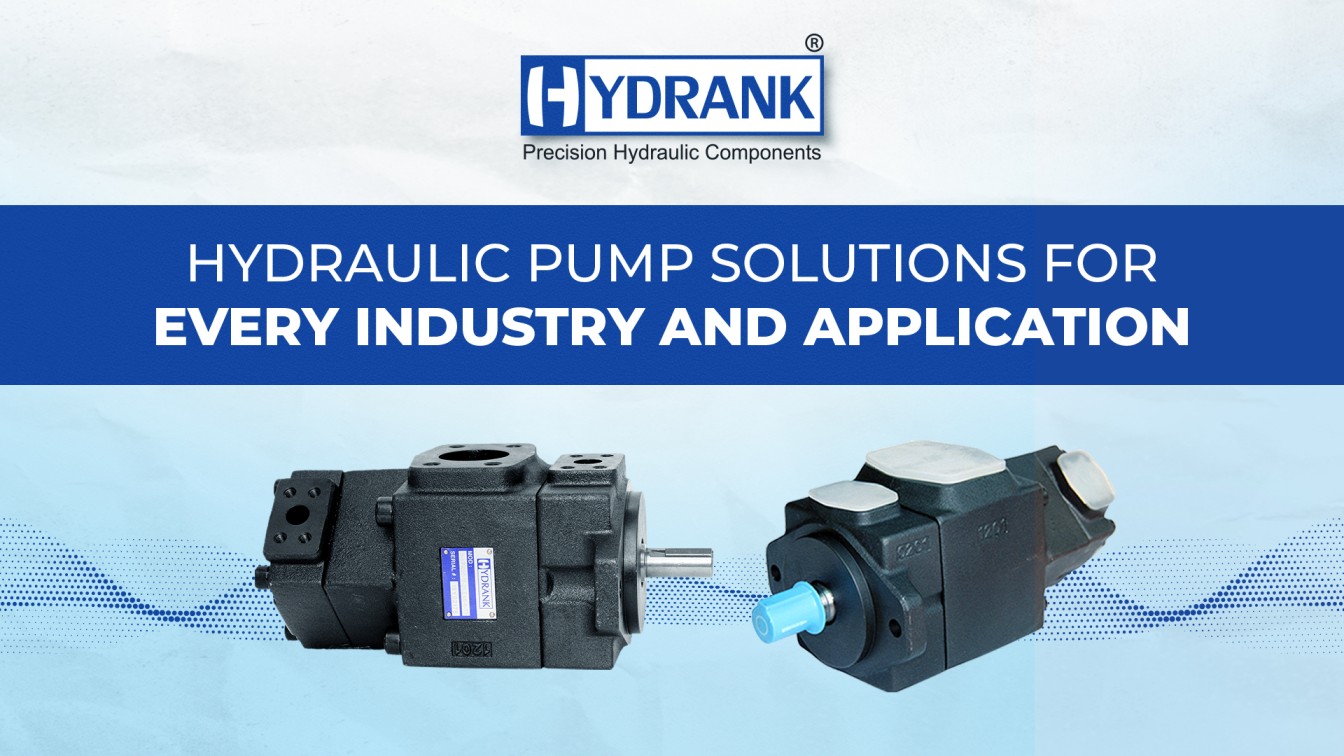-
Hydraulic Pump Solutions for Every Industry and Application

Hydraulic systems are known for their high power density, precise control, simplicity, safety, reliability and cost-effectiveness in their applications. As one of the important parts of any industrial machinery, these pumps are carefully chosen based on: Explore Hydraulic Pump Solutions for Every Industry and Application With Shriank
- Operating cycle
- System components
- Power source
- Hydraulic fluid
- Maintenance needs
In this article, we aim to address how hydraulic pumps work, some practical tips for selecting the right hydraulic pump for your application, which can help you make a more informed decision.
Functions of a Hydraulic Pump
- Converts mechanical power into hydraulic energy.
- Generates flow to overcome pressure from the load.
- Performs two main functions:
- Creates a vacuum at the pump inlet, allowing atmospheric pressure to push liquid from the reservoir into the pump.
- Delivers liquid to the pump outlet and forces it into the hydraulic system.
Common parts of the Hydraulic Pump & their Functions
Some of the common parts of the pump are stated below:
- Reservoir: It stores hydraulic fluid when it’s not in use. It also helps cool the fluid and remove air bubbles, which ensures the system’s efficiency.
- Pump: This robust component initiates and maintains the flow of the hydraulic fluid through the system, which provides a sense of control and power.
- Tubes or hoses: These are the ‘transporters’ of the hydraulic system, carrying the fluid from the pump to the hydraulic cylinder. They play an important role in maintaining the fluid’s flow and pressure.
- Actuators: Convert hydraulic energy into mechanical energy.
- Pressure relief valves: Control excess pressure by regulating the actuators and sending extra fluid back to the reservoir.
- Directional control valves: Adjust the flow size and direction of the hydraulic fluid.
Choosing Hydraulic Pumps: Key Points
Let our experts help you figure out how to choose the best pump for your industrial application.
- Part of the larger strategy: Hydraulic systems should be part of a broader power transmission plan, combining hydraulic with pneumatic, mechanical and electrical systems. If you aren’t sure, you can choose to work with reliable hydraulic manufacturers to develop this strategy.
- Pump use/function: Consider the pump’s intended function. Some pumps are specialised, while others offer more flexibility. You can choose a pump based on your requirements.
- Materials: Check the pump’s materials—cylinders, pistons and gears should be made of durable materials like aluminium, stainless steel or steel. Ensure these materials can handle both the hydraulic fluid and the operating conditions.
- Pump specifications: Match the pump’s specifications with your needs, including maximum pressure, horsepower, speed, power source and fluid flow. Ensure the pump can handle the demands of your machinery.
- System inefficiencies: Be aware of inefficiencies, like air bubbles in the system, which can waste energy. Choose high-quality components to minimise issues and focus on efficiency.
Hydraulic pumps are important in initiating the hydraulic process, moving fluid from the reservoir to the actuator through a tubing system. They should be chosen carefully to ensure efficient and reliable operation.
Applications of Hydraulic Pumps
Hydraulic pumps are useful in various set-ups, including:
- Operating construction equipment
- Lifting heavy objects
- Powering industrial machines
- Moving fluids through pipelines
They can be applied in many other situations as well. When selecting a hydraulic pump, consider your specific needs, such as whether you need high or low pressure and whether the pump should be self-priming or require an external fluid source.
Some of the major industries where they are put to use are:
- Automotive sector: Power steering, brakes and transmission systems.
- Construction equipment: Excavators, bulldozers and other machinery.
- Agricultural equipment: Tractors, combine harvesters and more.
- Aerospace industry: Aircraft brakes, landing gear and other systems.
With different types of hydraulic pumps available, choosing the right one is important for optimal performance and equipment safety. If you need more clarification, consult an expert to find the best pump for your application.
Safety Standards for Hydraulic Pumps
- Only use hydraulic pumps for their intended purposes.
- Inspect the system thoroughly before use.
- Shut down the system immediately if it overheats, loses pressure or stops working.
- Keep hands, arms, face and other body parts away from moving parts.
- Always wear proper personal protective equipment.
- Follow correct lockout procedures before maintenance.
- Ensure personnel are properly trained in pump handling.
- Never leave a running hydraulic pump unattended.
Hydraulic Pump Maintenance
Due to their complexity and potential danger, hydraulic systems demand the utmost caution in their handling. Even when the machine is off, the liquid pressure in hydraulic components can still pose a serious risk, making physical contact with them hazardous.
Using inadequate pumps can cause mechanical failures, which can lead to serious and costly consequences. However, the introduction of new diagnostic technology has revolutionised pump maintenance. It has significantly improved detection methods, going beyond just vibration signals. Measuring discharge pressures now allows for a more accurate forecast of pump wear. The addition of discharge sensors to existing systems further enhances the safety and reliability of hydraulic pumps.
Shriank Hydraulic Pumps
Choose Shriank Hydraulic pumps for all your industrial and other applications. Our product range includes Hydrank HVP Design pumps, Sarva Hydraulic Vane pumps and Hydrank H6 Series pumps. We also offer Tokimec Replacement Vane pumps, Vickers Replacement Vane pumps and Hydrank brand Direction Control Valves in 4WE and DSG Designs. We also provide Single, Double and Triple Vane Pumps, Proportional Valves, Pressure Control Valves, Hydraulic Relief Valves and more
India's Largest Hydraulic Vane Pump Supplier
contact us: +91 98980 09148
Delivery
Prompt and accurate delivery
Client Servicing
Pro after-sales customer support
Quality assurance
Top quality standards
Export
More then 10 countries
